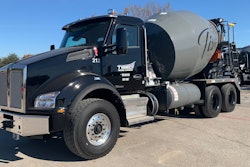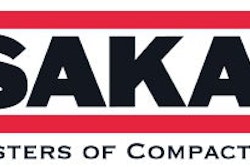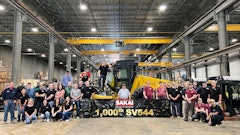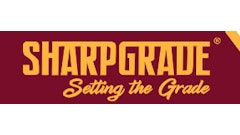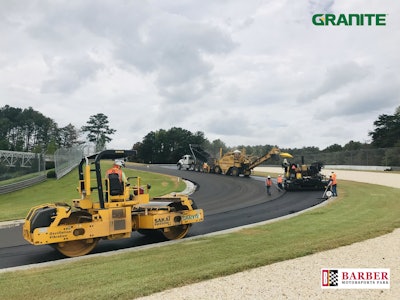
Contractors who have worked on a racetrack project know there is no shortage of challenges when paving these surfaces. When motor sports enthusiasts are traveling the pavement at high speeds, there is no room for error. The finished product must be flawless.
The Desert Cities Region of Granite Construction knows this to be true after repaving Barber Motorsports Park in Birmingham, Alabama. The existing pavement on the 2.38-mile road course was in desperate need of repair. The crew took on the challenge to complete the work but with no shortage of obstacles that needed to be overcome.
Planning for a Win
Granite was invited to bid on the project based on their knowledge and experience with this type of project. As one of the four firms to bid the project, Granite was awarded the project on March 1, 2019. Due to the complex nature of paving racetracks, extensive planning is required prior to the start of the project. The Barber Motorsports Park involved four months of planning.
Before work began, Granite met with several local vendors in the area to plan out the details of the project. The park closed on July 21, 2019. It was required that the entire scope of work be completed by the first week of September, which provided the team only 41 days from start to finish.
“We met with the project owners, consultants, asphalt plant, subcontractors, and several vendors 5 weeks before work was scheduled to begin,” Granite Project Manager Alejandro Salazar says. “We needed to make certain everything was carefully planned out because if one operation failed, the entire project could be jeopardized.”
After logistics were in place and the track was closed, demolition began. Crews worked on the removal of four inches of asphalt material using a Wirtgen W 210 Fi. More than 17,000 tons of material was removed down to four inches to accommodate the new surface.
Prior to the commencement of paving, they encountered soft spots in the subgrade which needed to be addressed. However, since the schedule for completion was extremely tight, the team worked with the project owners to identify an alternative that would allow for project completions within the tight timeframe.
“The project owners were able to fix the subgrade while we began paving other areas on the track,” Alejandro Salazar said. “Everything we did relied upon ways for us to work together to keep the project moving forward.”
Race to Perfection
Racetrack paving cannot be performed using the same processes and procedures as standard road paving. Extreme care and consideration need to be given to any joints that may be created by starts and stops in the paving process. In the case of this project, no starts and stops were allowed during paving, which required much logistical preparation for the crew.
"On a standard roadway, you typically adjust your paving pattern to minimize traffic impact and maximize productions," Granite Project Engineer Sibel Salazar says. "Stopping the paver, however, can create a bump. The fast speed of which a race car travels requires the smoothest surface possible. Per the specification, it was mandatory that the full lap of paving was completed with no stops to avoid any bumps that may be created.”
On this 45-feet wide track, the crew decided to pave in three continuous laps, starting with the inner, middle and then outer. The crew completed each 2.38 miles lap without stopping and then move to the next lap. They did this for each of the three layers of asphalt for a total of nine continuous laps. To accomplish this, the specifications required the paving speed to be 20 feet per minute in order to maintain a consistent speed.
“We developed many paving plans and had several backups in place to ensure all trucks arrived on time so we wouldn't have to stop the paver," Alejandro Salazar says. "The hot plant was tasked with producing the mix quantities to exactly match our production needs. This guaranteed the mix temperatures were optimal for placement and compaction."
The job required three different mix types:
1. Due to groundwater drainage issues, three corners of the track were first paved with 3 inches of porous, open-graded material to prevent water from collecting under the track. In these areas, 2,400 tons of mix was used.
2. Next, 7,800 tons of a PG 67-22 1/2-inch nominal maximum aggregate size (NMAS) mix was put down, approximately 2 inches thick for the base layer.
3. Finally, a PG 82-22 3/8-inch NMAS polymer modified mix was put down in two lifts for the leveling and surface courses. Each course was 1-1/2-inch thick, 5,740 tons per lift.
The old track was four inches thick and the new track was laid at five inches thick. Advanced Material Services (AMS), a pavement engineering and consultation service specializing in racetrack pavements, has specified this type of surface mix on racetracks around the country as it provides a balance of durability, traction and smoothness for both the project owners and end users.
While the mix is great for the end user, it causes more difficulties for paving contractors. This mix is very stiff for paving. Unlike roadway paving, the crew was also not permitted to walk on the mat behind the paver, adding an additional challenge to the work.
To complete the paving, compaction, and smoothness, the following equipment was used:
● Weiler 2850 Material Transfer Vehicle
● Caterpillar AP1055 F Asphalt Paver
● Sakai SW850ND Roller
● Sakai R2H Roller
● Sakai SW 654ND Roller
● Sakai SW 774ND Roller
● HAMM HD90 V for Edge Rolling
Based on successful working relationships with the Sakai team and equipment, the Granite crew selected to partner with Sakai for the compaction and smoothness scope of work.
"The team at Sakai helped us build other race tracks recently. Their engineers are great to work with," Alejandro Salazar says. "We rented the compaction equipment from them. They were available any time to discuss the challenges of the project. They provided different ideas when it came to compaction and smoothness. Their team of experts helped us fine tune our patterns."
The crew also had a backup piece of equipment ready in case there were any issues with the primary machines they were using.
Challenges Before Checkered Flag
With just 41 days to complete the project, the crew was already under a strict schedule. The condition of the weather did not make things any easier for them.
"The weather changes very quickly in Alabama. We had to monitor it closely since we couldn't stop paving once we started," Sibel Salazar says. "There were several days we had to cancel work due to the weather forecast and find alternate days to make up that time overnight and on weekends."
With the Desert Cities Granite team who completed the work based in Indio, California and the project located in Birmingham, Alabama, logistics and uncooperative weather were just a few challenges for the team. In order to ensure the job was completed correctly, Granite dedicated their team that specializes in racetrack paving. Granite flew their 28-person crew across the country to work on the project. They did this in order to ensure they could trust the people they have on the ground to complete the work to the high standards required on this strict and challenging project.
"Yes, the project was challenging,” Sibel Salazar said. “Despite of all the challenges, Granite completed a quality project safely and on-time while exceeding Barber Motorsport Park owner`s expectations.”





